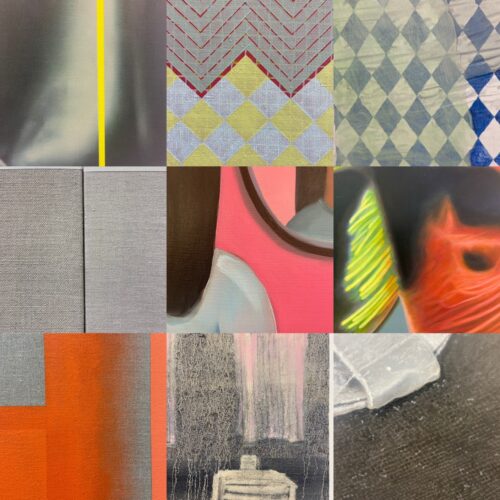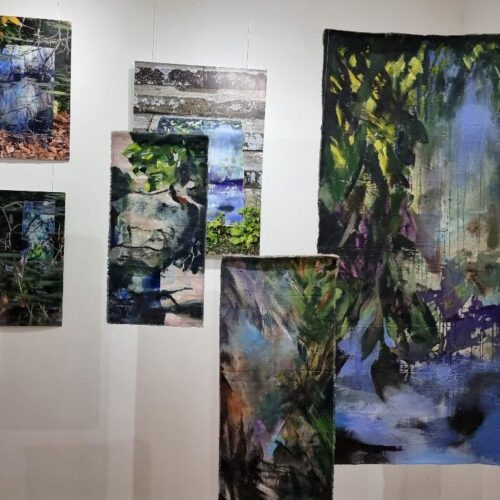
Study Visit Review: Cézanne & Rickards
By the time that our group of OCA students reached the Hannah Rickards exhibition at the Museum of Modern Art in Oxford, we had already spent an enjoyable morning looking at the exhibition, Masterpieces from the Pearlman Collection at the Ashmolean. We had also seen a smaller exhibition of Joseph Beuys’ works at the same venue. Hence, in approaching Rickards’ work, we were ready to accept that it as being about the language in which her collaborators expressed themselves rather than about what they actually had to say. And I mean ‘say’ since, unlike Cezanne’s systematic organisation of his visual responses to the landscape of Provence, Rickard’s work was all about listening rather than seeing. Her works explored people’s verbal descriptions of the ‘sound’ of the Northern Lights or their accounts of images seen as a result of mirages on the Great Lakes. She recorded them, typed them up and presented them as text on paper or on video.

It sounds simple but the nature of the transcriptions immediately altered their meaning. Hence, confronted by a five foot panel of closely-worked text about the Northern Lights, we were forced to stand back and scan back and forth along the sentences in ways that made them seem even more impenetrable. The ‘sound’ of the Northern Lights is itself an elusive phenomenon since it is something that cannot be recorded by a tape recorder. This is because it is not so much an audible sound as a vibration, which one student compared to the interference that one might detect from an electrical pylon. As an analogy, the artist put green filters over the windows in one half of the gallery so that when one looked from it to the other half, the second area appeared pink. The optical illusion was caused by the adjustment that the eye was forced to make in order to respond to the light. Hence, just as the Lights could not be recorded, so too the illusion could not be photographed.
The same subtlety can be found in a different piece in which the artist recorded the sound of a thunderclap and stretched it out so that it was several minutes long. She then commissioned a composer to reproduce the longer version, using traditional orchestral instruments, and compressed this second recording into a sound that was no longer than the original clap. Whenever the sound was broadcast, as it was several times in the time that we were there, it was impossible to distinguish it from the original. Image and representation were thus subtly intertwined. At this point, at least one of the students was tempted to ask: so what? And, indeed, a moment of doubt occurred for all of us when we entered a small room in which hidden speakers played different people’s descriptions of an abstract art work that was not physically present. The doubt was caused by a rather beautiful sound baffle that to all intents and purposes seemed to be the absent art work. With the confusion crept in a sense of the emperor’s new clothes.
No such reservations existed when it came to the exhibition from the Pearlman collection. If any of us had thought that a wealthy businessman who had made a fortune from refrigeration could be palmed off with a dodgy Soutine or a second-rate Cezanne, our doubts were quickly dispelled by the obvious quality of the works. Particularly impressive was Modigliani’s portrait of Cocteau, in which the painter seemed to have pinned the arrogant young man to the front of his canvas by the sharp points of his nose, chin and bow-tie. Equally enjoyable was a small sculpture by Modigliani, which contained references to Greek art and to the elongated shape of an Easter Islands head.

Then there were the Cezannes, which were beyond expectations – not just the big landscapes like the paintings of Mont Sainte Victoire but smaller, seemingly ‘unfinished’ drawings of a few trees in a wood or a bowl of unripe pears. Trying to work out what was an unfinished sketch, a note for a later painting or a ‘finished’ drawing was half the fun of the exhibition. So too was looking for his influence among the works by Pissarro and others, which were in the exhibition. This was particularly true of the big landscape paintings by Soutine of Ceret, in which the artist seemed to have borrowed some of the rhythms of Cezanne’s work but combined them with references to El Greco.
The tentative nature of many of Cezanne’ works – in which the line of a table-cloth seemed to start and stop or the colour in the contour of an apple was left half-filled in – resembled the ‘ums’ and ‘ers’ of Hannah Rickards’ collaborators. However, the resemblance was entirely superficial. Where Cezanne revised or excluded elements in order to create rhymes and correspondences within a composition, Hannah Rickards merely copied the patterns of her collaborators’ speech. Although their hesitations and elisions reinforced the sense of something unknowable, this was entirely fortuitous. As Dr Johnson famously said of the Giant’s Causeway, the show was worth seeing but not worth going to see. The opposite, in fact of Cezanne’s paintings of Mont Sainte Victoire.






I enjoyed this visit immensely, as I have any involving either Gerald or the Ashmolean, and especially both. I wrote up the visit here:
http://greenmangle.wordpress.com/2014/04/13/study-visit-cezanne-and-the-modern/
but miserably failed to write up Rickard’s Northern Lights, where Initially I enjoyed the idea but after two or three rooms, the idea had not gone the distance.